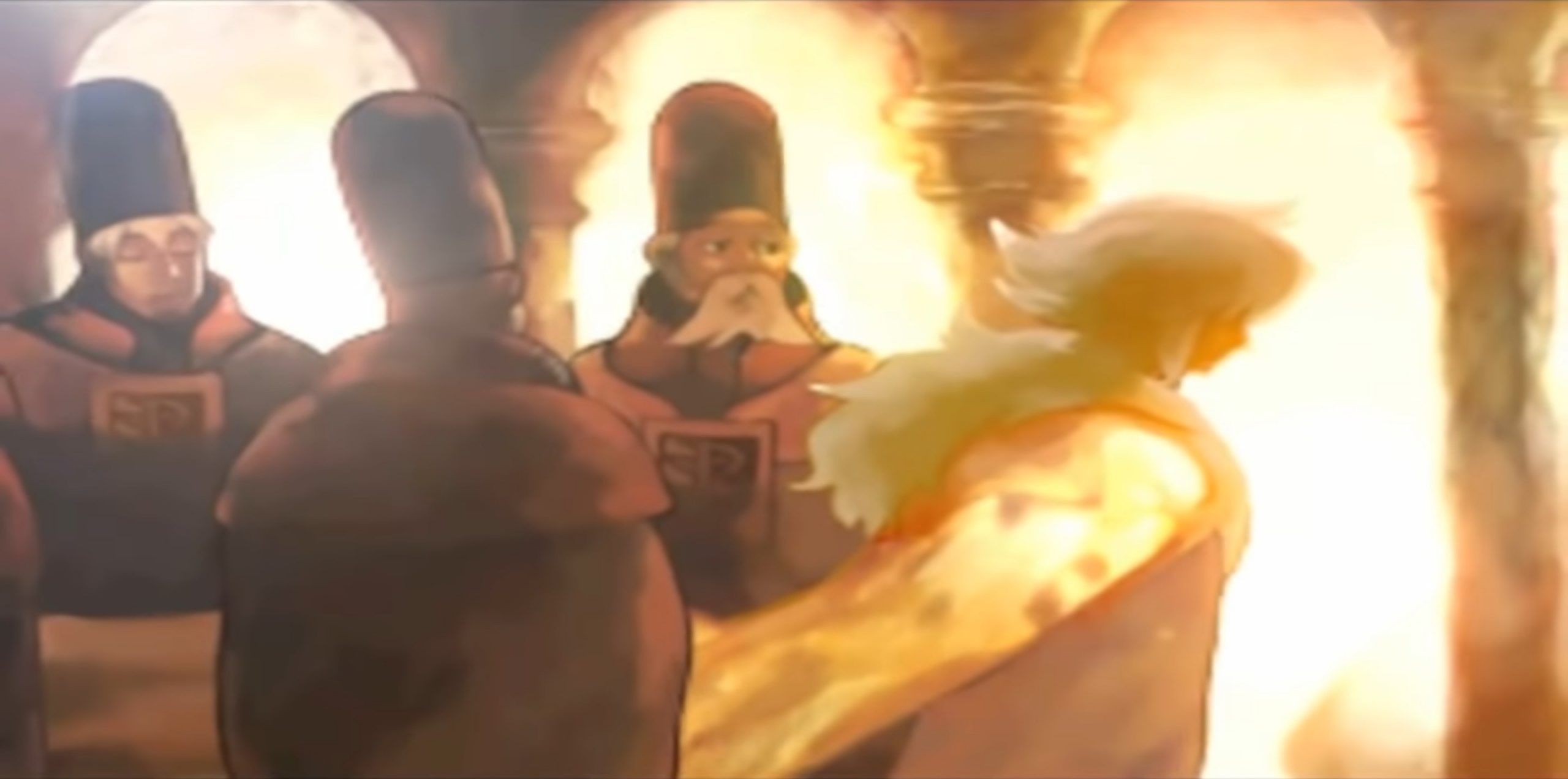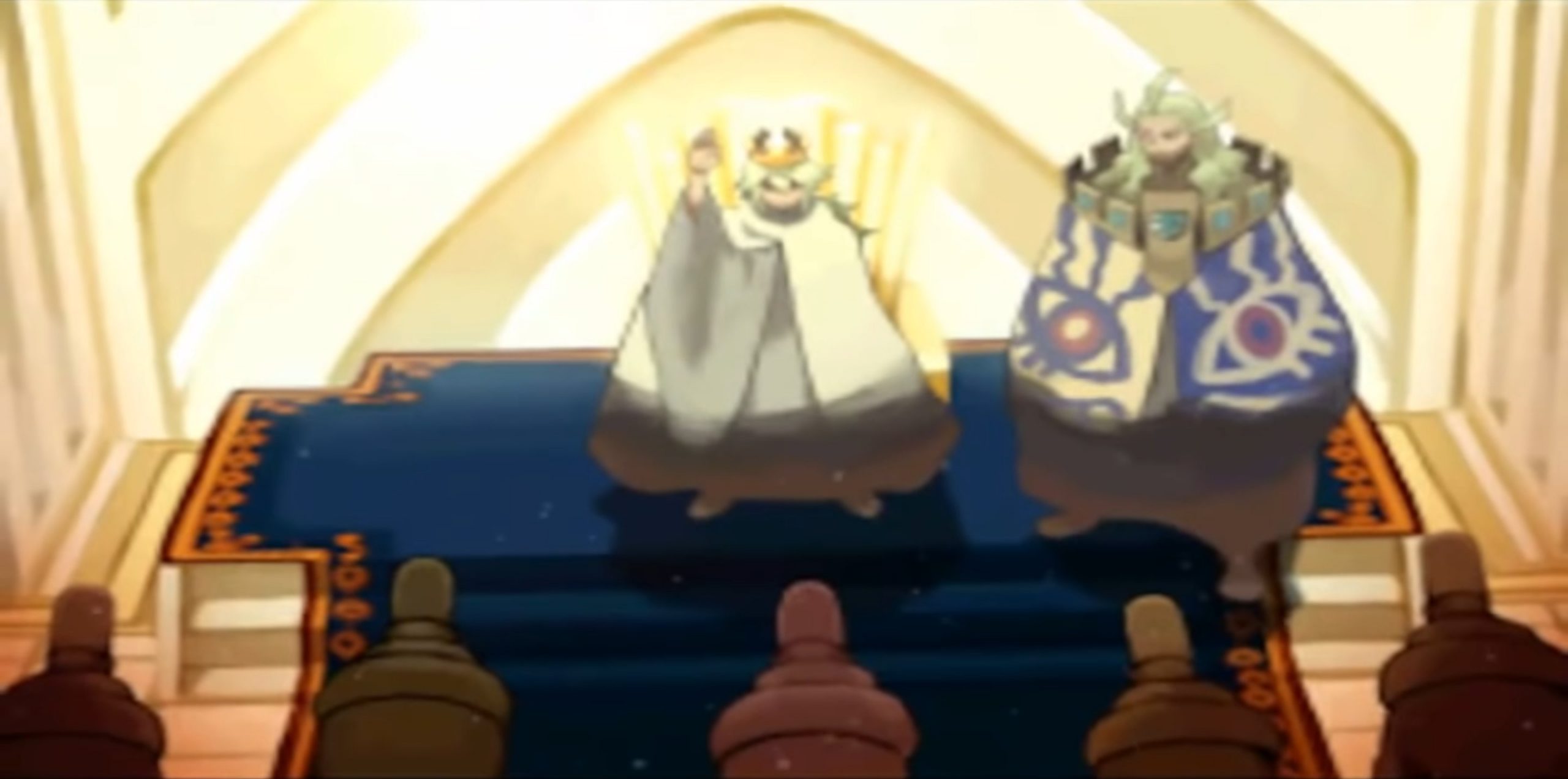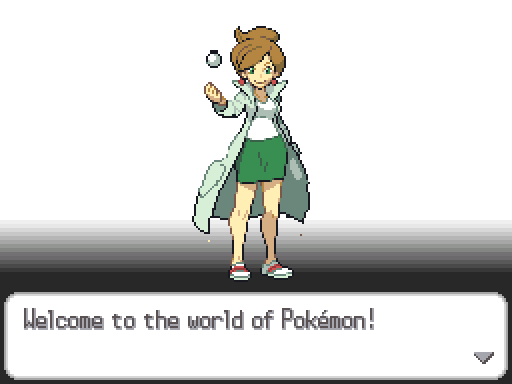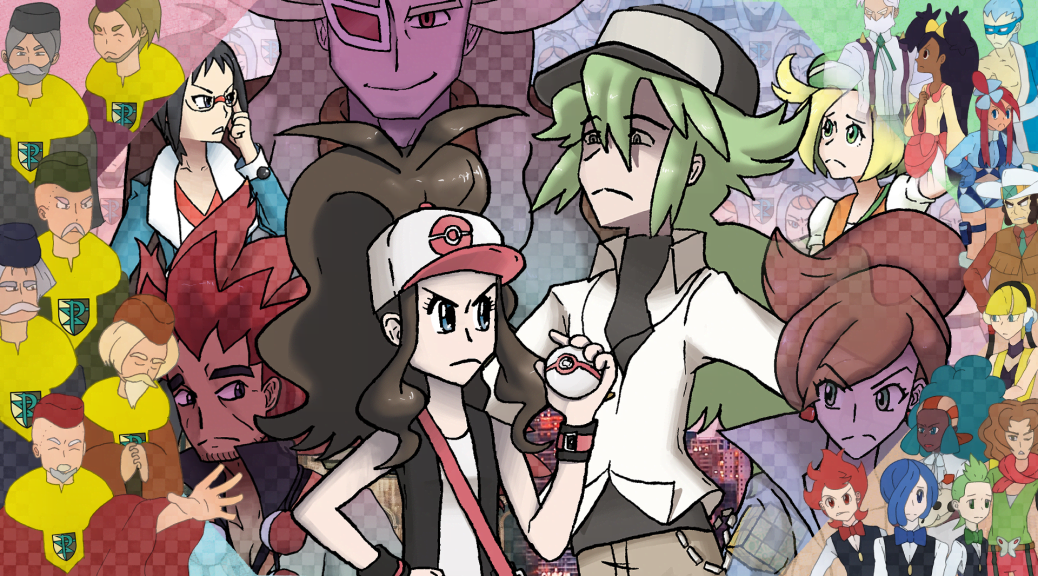Part II: The Chapters of Unova
For the anniversary of the release of Pokémon Black and White, we continue our tribute to the games. Part II focuses on the main storyline and its synthesis of narrative and gameplay.

Part II: The Chapters of Unova
Beginnings | Foundations | Castelia | Nimbasa | Driftveil | Chargestone | Icirrus
Dragonspiral | Reshiram & Zekrom | Relic Castle | The Stone | Opelucid | The League | N’s Bridge | The Sages
N’s Room | The End | Beginnings (Redux) | Kyurem | The Ruins | The End (Redux) | Champions
Grand and Humble Beginnings
It is coronation day. Within a castle, guarded by raised bridges that look almost like skyscrapers—a castle behind the New York City skyline—color-coded sages kneel and bow before a man wearing a castle of his own draped around his shoulders. He carries a crown towards a throne—empty now, but that will soon change.
Other sages escort a young man dressed in robes of the purest white towards his destiny—ready to be painted any color he chooses, or perhaps the colors of someone else’s choosing. The young man thinks back to his childhood, surrounded by Pokémon. He smiled then, but not now. People watch the coronation intently—this is the day that will change everything. The man with the crown holds it within his hands, his entire right arm decrepit and blackened. This will be the last time he can use this arm. But it’s not a concern, as the new king will be his new right hand.
The crown is set upon the young man’s head, and he opens his eyes. He raises his own right hand and addresses his people. He is now their king.
Hope. Dream. Discovery. Adventure awaits—for you and your Pokémon.
The opening to Black and White throws players directly into the midst of its narrative control by initiating the entire game with an important scene that occurs before the player even begins their journey. Right away we’re introduced to a crucial cast of characters—they’re the main antagonists, we will soon discover—and the game itself will soon introduce even more. This opening is also injected with hand symbolism that not only proves crucial to the interpretation of Ghetsis’s character, but immediately establishes that Black and White take a more literary approach to their storytelling than past series titles, with more blatant use of symbolism to give characters depth.
This is the only time Ghetsis uses his charred and blackened right hand. Otherwise Ghetsis only uses his left hand, with his right always hidden away in his robes. Historically, the left hand is representative of demons and evil.1 The Devil himself was thought to be left-handed, and anyone who shared the trait was considered a witch in the Middle Ages.2 Although this kind of bias against left-handed people has nearly ended in modern times, remnants can be seen through the etymology of the word “sinister”—defined by Merriam-Webster as “singularly evil or productive of evil,” which comes from Latin for “on the left side.”3 Similarly, its symbolic meaning, especially compared to the right hand, lives on. Hands themselves are incredibly powerful in iconography, “forceful enough to stand alone” according to journalist and art critic Jack Tresidder,4 and the most common body part appearing in symbol according to Professor Hans Biedermann.5
Consider how people raise their right hand to swear or speak honestly. Now compare the hands Ghetsis and N raise to address the members of Team Plasma. While N raises his right hand to address them honestly as their new king, Ghetsis earlier clutched the crown in his right hand, raising his left hand to address them as N was escorted in. Right off the bat we catch a glimpse at Ghetsis’s true colors while simultaneously viewing N’s genuineness. Ghetsis as a foil to N is the first major dichotomy revealed to the player, all during the opening animation.
The last we see of Team Plasma before the game truly begins is N addressing his people, standing to the right of Ghetsis—his figurative and literal “right-hand man” as N will unknowingly execute Ghetsis’s self-serving scheme. Now it’s time for the player to take matters into their own hands as they are thrust into their own destiny in the world of Pokémon.

This world is widely inhabited by mysterious creatures called Pokémon!” announces the leading researcher of the Unova region, Professor Juniper. Pokémon “come in many shapes and live in many different places,” mirroring the diversity in people. According to Juniper, “We humans live happily with Pokémon! Living and working together, we complement each other. We help each other to accomplish difficult tasks.” This is all well and good, and not at all unlike the similar speeches given by other regional professors to Trainers beginning their new adventures. But in Black and White, the collaboration between people and Pokémon is much more than just an idealistic statement used to establish the near-utopian state of the Pokémon world: it’s the source of the games’ conflict. Note that Juniper specifically refers to how Pokémon benefit from the assistance of people, a belief not shared by the games’ primary antagonist. Even the simple, oft-repeated assertion of how Pokémon battling “deepens the bonds between people and Pokémon” is also in direct opposition to what the antagonist believes. For the first time, the professor isn’t just welcoming players into the world of Pokémon. She’s introducing them to the games’ central conflict.
Juniper also briefly introduces the player’s friends. They will fill their role as “rivals” by challenging the player to battles to measure their progress throughout the story. Unlike most past titles, the player can’t choose to name these characters—as will be discussed later, their names are very important, and this helps establish them as more solidified individuals. Instead, Juniper describes these characters’ personalities: Cheren is “difficult” but “very honest,” while Bianca is “a little floaty” but “works very hard.” While players will not discover the disconnect between Juniper’s approval of Pokémon battles and research and Team Plasma’s goals until a tiny bit later, the brief introductions for Cheren and Bianca act as the second clue to the games’ emphasis on story and character, following the look into N’s coronation.
Before sending the player off, Juniper leaves them with one last thought to chew on:
“During your journey, you will meet many Pokémon and people with different personalities and points of view! I really hope you find what is important to you in all of these travels… That’s right! Befriend new people and Pokémon and grow as a person! That is the most important goal for your journey!”
And she couldn’t be more correct. Like all mainline Pokémon game narratives, Black and White boil down to a “coming-of-age” story, but this time place focus on a more realistic approach of clashing beliefs and overcoming their ensuing adversity. Hopes will be born, dreams will be challenged, and discoveries—of both the self and the world—will be made on this Pokémon adventure. This is what’s most important on this journey, far more than completing the Pokédex, or even becoming the Champion.
The newly-crowned king and the new Trainer from a small little town—the paths of these two drastically different people are about to cross.

The professor leaves a box of Pokémon for you and you friends at your house in Nuvema Town. Mistakes are made due to lack of experience—choices in battle that lead to a loss, either for your friends or yourself. Mistakes are also made as a result of lack of control, and your room is ruined during the battle with Bianca. But mistakes are just a part of growing up. Your mother lets you leave to thank the professor, but while Cheren goes ahead to wait outside her lab, Bianca wishes to speak with her family first. As you exit your house to follow her, some Pokémon flutter away—either Pidove during the day, or Woobat at night, a charming detail symbolic of the freedom you and your friends now have as your journey begins.
But when you go to check on Bianca, you walk into a shocking scene. Before even getting to meet the professor face-to-face, Bianca’s subplot kicks off with her narrowly escaping her house as her father refuses to allow her to go on an adventure with Pokémon. In addition to setting up themes right away, Black and White waste no time in getting the story’s conflicts running.
After visiting the professor to receive your Pokédexes, she moves on ahead, giving you the chance to take a leisurely trek through Route 1. Here, most other games in the series would have you partake in boring errand-running, making you move through routes and towns without Poké Balls, return back to the professor, and then press forward again through the routes and towns you’ve already seen, Black and White, on the other hand, utilize a structure that minimizes needless backtracking. All the while, the professor is relevant and, most importantly, active, leading the way rather than dissolving into irrelevancy after giving you your Pokémon and Pokédex.
When you all arrive at Accumula Town, Juniper gives you and Bianca a quick tour around the combination Pokémon Center-and-Poké Mart. Once you finish up inside, you notice some commotion outside. Joining up with Cheren, you look on as a man calling himself Ghetsis, claiming to be part of a group called Team Plasma, gives an impassioned speech before an anxious crowd—and what he says goes against everything players have come to know about the Pokémon universe:
“I’m sure most of you believe that we humans and Pokémon are partners that have come to live together because we want and need each other. However… Is that really the truth? Have you ever considered that perhaps we humans… only assume that this is the truth? Pokémon are subject to the selfish commands of Trainers… They get pushed around when they are our ‘partners’ at work… Can anyone say with confidence that there is no truth in what I’m saying? Now, ladies and gentlemen, Pokémon are different from humans. They are living beings that contain unknown potential. They are living beings from whom we humans have much to learn. Tell me, what is our responsibility toward these wonderful beings called Pokémon? That’s right! We must liberate the Pokémon! Then, and only then, will humans and Pokémon truly be equals. Everyone, I end my words here today by imploring you to consider the relationship between people and Pokémon… and the correct way to proceed.”
The man named Ghetsis and the grunts who accompany him file out in an almost mechanical fashion, and leave behind a concerned, confused, and questioning crowd. Cheren, however, is firm in his resolve that people and Pokémon benefit from each other. Then, a mysterious young man approaches the two of you.
He speaks far too fast, this odd man. And he says strange things, like how he can hear Pokémon talking. He challenges you to battle with nothing but a lone Purrloin. He says he wants to change the world because Pokémon are his “friends.” This is your first meeting, but you’ve seen him before. There’s no mistaking that the man called N was the one being crowned by Ghetsis, and the emblem on the Team Plasma banners is the same as the one emblazoned on the cloaks of the sages who were there. They are connected, and they are crucial to your adventure. Before meeting even a single generic Trainer, you have met the most pivotal characters in the game, and their plots have been set in motion. The clouds are gathering overhead as you take your first big strides forward on your journey.

